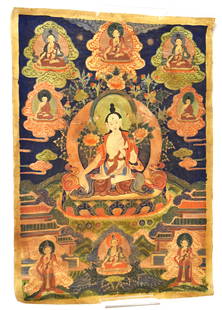
19th C. Tibetan Tsongkhapa / Elephant Thangka
Similar Sale History
Recommended Items







Item Details
Description
Tibet, ca. late 19th to early 20th c. CE. An embroidered silk thangka painstakingly created with a very fine "Dazi" stitch (also called "Forbidden Stitch" or "Blind Stitch") depicting Tsongkhapa (also Je Tsongkappa ), a major religious reformer of Tibetan Buddhism, here portrayed riding an elephant on a lotus base, surrounded by a picturesque landscape, clouds, and flowing waters. Below are the Wrathful Yama and his consort and twin sister Yami; the Wheel of the Law upon a lotus blossom on the lower left, Tibetan script that translated to, "Tsongka riding on elephant" on the lower right, and an orb-shaped sun and moon near the upper corners. A breathtaking composition mounted on a golden silk mat, replete with rich iconography, stunning design, a brilliant graduated color palette, and a rare masterful command of the refined Dazi Stitch. Size: 34.125" L x 25.25" W (86.7 cm x 64.1 cm); 37.75" L x 28.75" W (95.9 cm x 73 cm) including border
Tsongkhapa (also Je Tsongkhapa or man from Tsongkha, 1357-1419) sometimes referred to as "the Man from Onion Valley" was a very famous teacher of Tibetan Buddhism whose teachings and actions led to the founding of the Gelug school of Tibetan Buddhism. He is also sometimes known by his ordained name: Losang Drakpa or "Je Rinpoche."
The Dazi (Forbidden Stitch or Blind Stitch) refers to the knotted stitches used in conjunction with satin stitches that were reserved for the most exquisite, finely crafted silk costumes, robes, and rank badges. One romantic legend offers that the alternative term Blind Stitch arose because embroidering with this stitch gave young girls eye strain due to its fineness and intricacy. Whether called the Dazi stitch, the Forbidden Stitch, or the Blind Stitch, these all involve making small knots on the fabric surface by wrapping a heavy embroidery thread, typically silk floss, around a needle and then stitching it down. Embroiderers have done this with varying numbers of wrappings and a wide range of complexity. According to expert Wang Yarong, more than twenty varieties of knot stitch can be found throughout history, in East Asia alone. Apparently, early relics of this stitch have been found in an Eastern Han tomb at Nuoyinwula, Outer Mongolia, and even earlier examples on a pair of silk shoes were discovered in a tomb of the Warring States period in the Linzi, Shandong Province.
Provenance: private Bricker collection, Charlottesville, Virginia, USA
All items legal to buy/sell under U.S. Statute covering cultural patrimony Code 2600, CHAPTER 14, and are guaranteed to be as described or your money back.
A Certificate of Authenticity will accompany all winning bids.
We ship worldwide to most countries and handle all shipping in-house for your convenience.
#124144
Tsongkhapa (also Je Tsongkhapa or man from Tsongkha, 1357-1419) sometimes referred to as "the Man from Onion Valley" was a very famous teacher of Tibetan Buddhism whose teachings and actions led to the founding of the Gelug school of Tibetan Buddhism. He is also sometimes known by his ordained name: Losang Drakpa or "Je Rinpoche."
The Dazi (Forbidden Stitch or Blind Stitch) refers to the knotted stitches used in conjunction with satin stitches that were reserved for the most exquisite, finely crafted silk costumes, robes, and rank badges. One romantic legend offers that the alternative term Blind Stitch arose because embroidering with this stitch gave young girls eye strain due to its fineness and intricacy. Whether called the Dazi stitch, the Forbidden Stitch, or the Blind Stitch, these all involve making small knots on the fabric surface by wrapping a heavy embroidery thread, typically silk floss, around a needle and then stitching it down. Embroiderers have done this with varying numbers of wrappings and a wide range of complexity. According to expert Wang Yarong, more than twenty varieties of knot stitch can be found throughout history, in East Asia alone. Apparently, early relics of this stitch have been found in an Eastern Han tomb at Nuoyinwula, Outer Mongolia, and even earlier examples on a pair of silk shoes were discovered in a tomb of the Warring States period in the Linzi, Shandong Province.
Provenance: private Bricker collection, Charlottesville, Virginia, USA
All items legal to buy/sell under U.S. Statute covering cultural patrimony Code 2600, CHAPTER 14, and are guaranteed to be as described or your money back.
A Certificate of Authenticity will accompany all winning bids.
We ship worldwide to most countries and handle all shipping in-house for your convenience.
#124144
Condition
Silk border shows slight discoloration/staining, expected fraying, and minor losses. Embroidered composition is overall excellent.
Buyer's Premium
- 24.5%
19th C. Tibetan Tsongkhapa / Elephant Thangka
Estimate $6,000 - $8,000
3 bidders are watching this item.
Get approved to bid.
Shipping & Pickup Options
Item located in Louisville, CO, usSee Policy for Shipping
Payment

Related Searches
TOP


















































